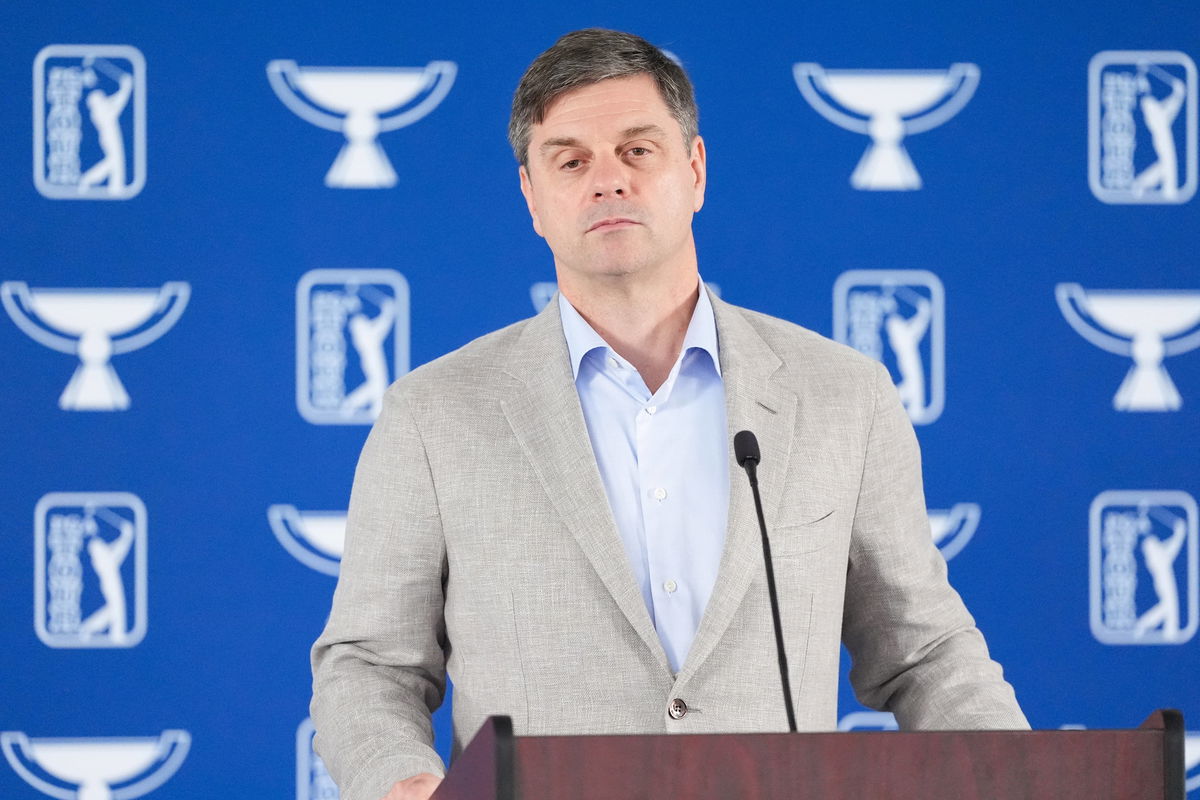
Imago
August 20, 2025, Atlanta, Georgia, USA: Brian Rolapp, Chief Executive Officer of the PGA, Golf Herren Tour, speaks to the media ahead of the 2025 TOUR Championship at East Lake Golf Club. Atlanta USA – ZUMAw109 20250820_fap_w109_006 Copyright: xDebbyxWongx

Imago
August 20, 2025, Atlanta, Georgia, USA: Brian Rolapp, Chief Executive Officer of the PGA, Golf Herren Tour, speaks to the media ahead of the 2025 TOUR Championship at East Lake Golf Club. Atlanta USA – ZUMAw109 20250820_fap_w109_006 Copyright: xDebbyxWongx
The PGA Tour’s new schedule has already sparked considerable controversy. Attracting sharp jabs from golf analysts and veterans like Lucas Glover, the future of the PGA Tour hangs in uncertainty. While the 2026 schedule raises questions about the profit-driven atmosphere, one insider has outlined what it might look like for lower-ranked and younger golfers on the circuit.
Watch What’s Trending Now!
Andy Johnson, PJ Clark, and Brendan Porath joined for a conversation on the Fried Egg Golf podcast. They discussed Tiger Woods‘ latest surgery, the Baycurrent Classic, and, well, the controversial 2026 schedule. That’s when Johnson spelled out the Tour’s biggest issue. “The other aspect of the schedule that we have to keep in mind is that guys play pretty much the same schedule now.
And when you throw in players like Scottie, Rory, and other elite players, there aren’t as many wins available as there used to be,” Johnson said in the podcast.
ADVERTISEMENT
With the introduction of more no-cut $20 million signature events crammed between majors, the elites would all chase guaranteed money at the big events. That would make it harder for the mid-tier to find footing in such events.
Moreover, with limited field sizes and reduced Tour cards, the Tour has barricaded entry to these events, making them exclusive to the headlining stars. As a result, fewer wins will be available to newer players. Naturally, the lesser-known names will struggle to advance their career inside the Tour.
Johnson’s remark earned a sarcastic comment from Porath and Clark, who suggested shifting to smaller events like the Baycurrent Classic or the John Deere Classic. That might provide a chance to secure wins with the elites out of the field. However, the truth of this statement stings despite being a humorous comment.
ADVERTISEMENT
With 9 signature events out of 36 regular-season tournaments, the opportunities are already scarce. It could be that, in the future, the Tour cuts out on regular-season events to make space for these signature events.
As a matter of fact, the Tour’s signature events are big-money tournaments as well, with popular faces. It would only make sense for the PGA Tour to focus more on established players than on rising stars.
ADVERTISEMENT
Next season’s PGA TOUR schedule is here!
2026, we’re ready for you 💪 pic.twitter.com/yRT2iRavba
— PGA TOUR (@PGATOUR) August 19, 2025
Porath expressed similar concerns. “I was going to say, there might be even more scarcity ahead. Who knows? In addition to a lot of guys playing the same schedule, we might see fewer events coming down the line.
There might be fewer opportunities — there may be no Bay Current, there may be no Sanderson in the fall,” the insider shared with the others.
ADVERTISEMENT
Earlier, the reigning golfers would spread out their schedules, with a balance of big names and rising hopefuls in the fields. Now, with the $20 million events and majors jam, other regular-season events would become optional.
That would make it harder for smaller events to attract sponsors. And reduced profits would lead to the Tour ending those operations, as Porath predicted for events like the Baycurrent Classic.
Johnson agreed with Porath on the sentiment. In fact, in a sarcastic tone, Johnson joked that, in the future, a Hall of Fame career might look like 5 wins. Yes, it’s a cruel insight, given that previous legends have raked in over 70 wins.
ADVERTISEMENT
But the statement doesn’t seem much further from reality either, with wins getting scarcer. The scariest part, however? It’s when Johnson stated, “This is carving the future in real time. We’re already talking this into existence.”
With the schedule already confirmed and the elites locked in for the signature events, that future might not be far. However, while we know the addition of the new signature event —the Miami Championship —how does that change the schedule? And what does the controversial 2026 schedule even look like? Let’s take a look.
Top Stories
PGA Tour Injury Report: Viktor Hovland Drops Recovery Update Before New Season Kicks Off

Scottie Scheffler & Rory McIlroy Fans Lock Horns as PGA Tour Nominates Them for Top Honor

Paige Spiranac Opens Up on ‘Anxiety’ Struggles That Ended Her Professional Golf Career

Tiger Woods Unwilling to Let Charlie Woods Down as He Makes Tough PNC Championship Decision

Golf Veteran, 90, Pays Emotional Tribute to Fuzzy Zoeller Days After His Passing

ADVERTISEMENT
Brian Rolapp’s 2026 PGA Tour schedule in a nutshell
The 2026 schedule is a new era of signature events and beef with the lower-ranked golfers. That’s a way to put it. But the latest Trump venue Miami Championship at Doral, that’s how it’s looking.
That marks the 9th signature event, and it comes with considerable criticism, especially from Lucas Glover. This would create scheduling stress for top golfers while putting pressure on smaller events already fighting for relevance.
Moreover, being placed right before another signature event —the Truist Championship and a major, the PGA Championship —the elites would have to choose between the events to avoid fatigue. A notable run in spring will feature: The Masters, RBC Heritage, Zurich Classic, Miami Championship, Truist Championship, PGA Championship.
ADVERTISEMENT
That’s two majors and three signature events in about six weeks. This will force tough choices, threatening the significance of signature events as top golfers look out.
For some, it also means another money grab, with less competition due to smaller fields. No cuts make matters worse, with these signature events essentially guaranteeing money for millionaire golfers while other players struggle to get jobs.
In addition, the Tour has reduced the number of full-exempt cards from 125 to 100. Yes, that means even fewer opportunities for the lower-ranked golfers. Alongside fewer full-field events, the PGA Tour has become a financial minefield for the top 1%, while others struggle to even get into the Tour.
ADVERTISEMENT
As is clear, Porath and Johnson’s words couldn’t ring truer. The Tour is suffering from a massive crisis for lower-ranked golfers. If the PGA Tour plans on revolutionizing the sport, it needs to adopt a better approach, as the insiders outlined.
ADVERTISEMENT
ADVERTISEMENT
ADVERTISEMENT

.png?w=50&h=50)
